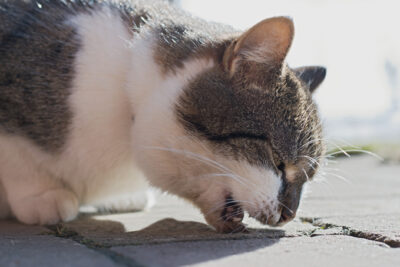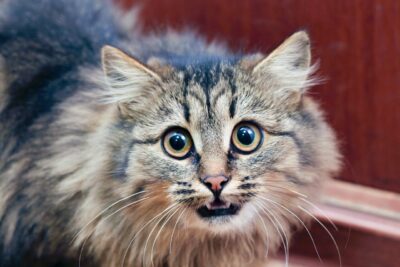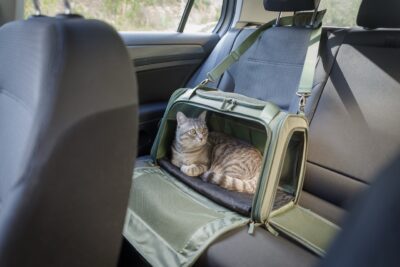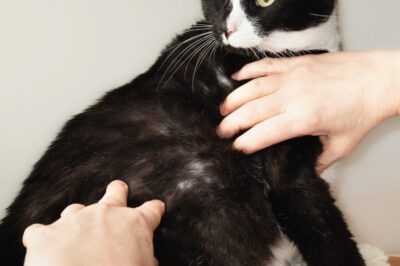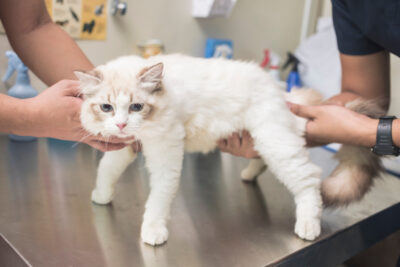Cryptococcosis in Cats

Overview
Pigeons: they’re everywhere, especially if you live in or visit a big city like New York City. Pigeons are beautiful, gentle little birds. They even have a part in war history due to their ability to fly long distances with messages attached to their legs. But why are they called “flying rats”? Perhaps it’s because pigeons can carry germs that can make pets and people sick.
Pigeons — as well as some other birds — are known to carry a fungus that can cause an illness called cryptococcosis in cats, humans, and other species, including dogs. But before we blame pigeons for this disease, read more to better understand the many places it can come from, what symptoms to watch for, and how to treat it.
What Is Cryptococcosis in Cats?
Fungal infection is rare in cats, affecting only about 7 out of every 10,000 cats (1). Cryptococcosis is the most common fungal infection in cats, but it is not common by any means. Cryptococcosis means infection with the fungus Cryptococcus — typically, Cryptococcus neoformans or Cryptococcus gattii.
The fungus is first inhaled into the nose and lungs and can spread throughout the body through the bloodstream. Most commonly, it spreads from the nasal cavity to the skin, eyes, and central nervous system, such as the spine and the brain. Cryptococcosis is particularly dangerous in cats if it infects the central nervous system and eyes. Medications do not reach these areas well, and the symptoms are severe.
Cryptococcus infects indoor and outdoor cats alike — indoor-only cats can be infected! All ages of cats can be affected, but younger cats are more likely to get the disease. Certain breeds of cats have higher rates of cryptococcosis, including Siamese, Himalayan, Birman, and Ragdoll breeds.
Cryptococcosis in Cats: Causes

Cryptococcus is found worldwide. Cats inhale the fungus by interacting with birds or their feces (poop), or by exposure to many other outdoor elements, such as soil, trees, water, and air. Birds — especially pigeons — have the fungus in their poop, and pigeons can even carry it on their feathers or different areas of their body. Indoor cats are thought to be exposed to Cryptococcus found in plant soil or mulch used on indoor plants. Cats may also be infected by having a wound that allows Cryptococcus to enter the body.
Once cats inhale the fungus, it sticks to the lining of the nasal cavity and/or the lungs. The protective capsule around the fungus grows, preventing the body from getting rid of it. The capsule prevents the body’s immune system cells from eating and destroying it (a process known as phagocytosis). The capsule also limits the body’s response, so many immune system cells meant to protect the body may not recognize it as bad or may not send cells to fight it. Cryptococcus can then spread to other areas of the body through the bloodstream.
Per the Centers for Disease Control and Prevention (CDC), cryptococcosis is not contagious (2). This means that cats cannot spread the infection to one another, and cats do not spread the disease to humans. In theory, it is possible, but this has never been proven or shown to occur.
Cryptococcosis Symptoms in Cats

There are many possible signs of cryptococcosis because the fungus can infect any part of the body and cause a variety of symptoms. The fungus is very small — too small for the eye to see. The most common cryptococcosis symptoms in cats include:
- Less activity
- Decreased appetite
- Weight loss
- Sneezing
- Discharge from the nose
- Congestion, or louder sounds while breathing (stertor or snoring)
The skin is affected in about half of cats with cryptococcosis. The most common areas affected are the face, ears, and paws. These skin symptoms may include:
- Swollen bridge of the nose, almost like a large bump
- Small red bumps (papules)
- Raised firm lumps under the skin (nodules)
- Oozing small wounds (draining tracts or abscesses)
Approximately one-quarter of cats with cryptococcosis have symptoms in the eyes and the central nervous system. These symptoms may include:
Eyes
- Blindness
- Redness in the eye
- Cloudiness in the eye
- Swelling around the eye
- Eye(s) bulging outward
- Pupils (black central part of the eye) are different sizes
Central nervous system (i.e., brain, spinal cord)
- Behavior changes
- Seizures
- Twitching
- Head tilted to one side
- Stumbling while walking (ataxia)
- Weakness or lack of movement in back or all legs
- Pain (i.e., cry out or turn around to bite) when petting the back, jumping, moving
- Walking in circles with less walking in a straight line
In rare cases, cats may develop urinary tract symptoms, such as urinating outside the litter box or in small amounts multiple times per day; limping on legs with swelling around joints; kidney disease causing vomiting and general symptoms of not feeling well; and ulcerations in the mouth leading to pain and bad breath.
Diagnosing Cat Cryptococcosis

Veterinarians will first perform a thorough physical examination on the cat, looking for abnormalities in a variety of body systems. A classic finding is a large bump on the bridge of a cat’s nose, but that is not always present. Sometimes veterinarians can diagnose cryptococcosis under the microscope by finding the fungus in discharge from the nose or skin using cytology. However, laboratory testing on blood, urine, discharge, and occasionally cerebral spinal fluid (CSF) is likely required.
There are many tests to look for cryptococcosis, and at times diagnosis is difficult. Multiple tests are likely needed. General blood work helps identify which organs are involved with the infection. Discharge from the nose, fluid from skin lesions, urine, samples of CSF, and samples of tissue can be cultured to grow the fungus in the lab. Samples of tissue (i.e., a biopsy) can also be examined by a pathologist, who may find the fungus in the sample. Blood can be sent to the lab to look for antibodies in very high quantities, which would strongly support the diagnosis of cryptococcosis. This blood test is not always accurate if the fungus is only found in one area of the body or in the central nervous system. Another blood test called polymerase chain reaction (PCR) testing is available that looks for genetic material (DNA) of the fungus to diagnose infection.
Treatment for Cryptococcosis in Cats
Cryptococcosis requires the use of antifungal medication over long periods of time, typically four months to a year. About one-third of cats may experience relapses (3), which would require retreating your cat with antifungals again in the future. Most cats take antifungal medication at home until two months after symptoms resolve, or blood testing no longer shows Cryptococcus is present. Severe cryptococcosis involving the brain or spine or cryptococcosis that has spread throughout the body will require more intense treatment involving injections in the veterinary hospital and oral medications (i.e., medications given by mouth at home).
Medications for Cryptococcosis in Cats

Medication for treating cryptococcosis in cats may include:
- Amphotericin B (AMB). This is the most effective antifungal available. AMB must be injected three times per week in the hospital and is typically used with another antifungal given by mouth. For cats with cryptococcosis affecting the spine or brain, this intensive treatment is strongly recommended. AMB can cause damage to kidneys, so frequent testing of kidney function is required.
- Flucytosine. This oral antifungal (meaning it is given by mouth) cannot be used alone. It is given along with AMB if your cat’s cryptococcosis involves the central nervous system or they have cryptococcosis throughout the body.
- Fluconazole. This oral antifungal is the most effective azole antifungal against cryptococcosis. It requires shorter treatment times than itraconazole and is relatively inexpensive. Some Cryptococcus are becoming resistant, however.
- Itraconazole: This oral antifungal is the second choice of azole antifungals used against cryptococcosis. A trusted brand name is Itrafungol. Treatment takes twice as long as treatment with fluconazole; however, if there is resistance to fluconazole, itraconazole is the next best choice.
General Cost to Treat Cryptococcosis in Cats

There are many costs even before treatment begins. Many cats who present to the veterinarian with general symptoms will go through a wide variety of tests before diagnosing cryptococcosis. This may include a veterinary examination, general blood work, x-rays, and cytology or aspirates of suspicious lesions. Costs will range greatly depending on where you live and how sick your kitty is, but typically will run several hundred dollars. If your veterinarian needs to do minor surgery and take a biopsy of a lesion on your kitty, this will cost an additional several hundred dollars.
Laboratory testing for cryptococcosis costs a couple hundred dollars apiece, so your veterinarian will do their best in choosing the test that makes the most sense for your cat. Keep in mind that multiple tests may be needed to definitively diagnose cryptococcosis.
Fluconazole is less expensive than the other medication choices. If finances are a concern, and your cat is not severely ill, this will be your most affordable option and costs approximately $30-$45 per month. Keep in mind that most cats require multiple months of treatment.
In order to know when to stop treating your cat, veterinarians will typically recommend retesting your cat’s antibodies once per month, which will cost a couple hundred dollars per month. The monthly veterinary recheck is important to ensure that your cat’s symptoms are decreasing and your cat is doing well overall, such as maintaining or gaining weight.
How to Prevent Feline Cryptococcosis in Cats

Prevention of cryptococcosis is very difficult. Cryptococcus lives all over the world and throughout nature. If possible, prevent your cat from interacting with pigeons or from visiting places in which pigeons typically nest or have defecated.
Cryptococcosis in Cats FAQs
Is cryptococcosis in cats curable?
Yes, cryptococcosis in cats is curable, but some cats may relapse. This means they may experience the disease again even after appropriate treatment. It is much harder to treat cats with disease of the brain or spine.
Can humans get cryptococcosis from cats?
No, cryptococcosis has never been shown to spread from cats to humans. According to the CDC, it does not spread between people or between people and animals. In theory, cats could shed some fungus in their secretions, but it does not get into the air, which is the way that humans are infected (after inhaling spores).
Is cryptococcosis in cats contagious to other cats?
No, cryptococcosis does not spread from cat to cat. Cats become infected by inhaling (or breathing in) fungal spores from dirt, trees, water, air, or through interactions with birds or their feces.
References
- “Cryptococcosis.” Cornell University College of Veterinary Medicine. Retrieved from: https://www.vet.cornell.edu/departments/cornell-feline-health-center/health-information/feline-health-topics/cryptococcosis
- “Cryptococcosis: Causes and How It Spreads.” CDC. Retrieved from: https://www.cdc.gov/cryptococcosis/causes/index.html
- Trivedi SR, Malik R, Meyer W, Sykes JE. Feline Cryptococcosis: Impact of Current Research on Clinical Management. Journal of Feline Medicine and Surgery. 2011;13(3):163-172. doi:10.1016/j.jfms.2011.01.009

